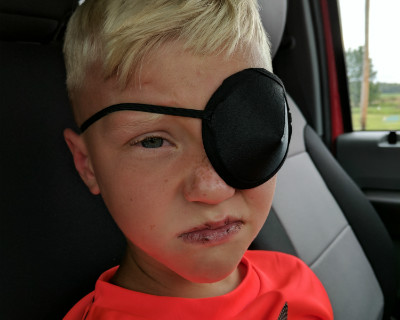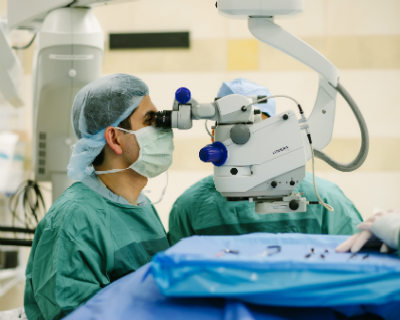Colton Thompson had his vision restored thanks to a cornea transplant after a serious fishhook injury.
At age 7, Colton Thompson received the best gift ever – sight. Colton's vision began to dim not long after he suffered a gruesome fishing accident. In eager anticipation of a big catch with a new lure, his older brother sent a hasty cast into Colton’s left eye. After emergency surgery to remove the lure, it appeared he might escape lasting damage. But then the pain started, and he was unable to see well, even with glasses. Colton would need a new cornea, the clear, dome-shaped surface that covers the front of the eye. Thanks to the generosity of a cornea donor and a talented ophthalmologist, Colton’s vision was restored.
Living in rural Michigan, Colton's parents, Katelyn and Jacob, took a carefree attitude to parenting their six children. "Just let kids be kids," his mom Katelyn likes to say. The warm, summer day Colton and his four, towheaded brothers set off for the pond on their property was no different.

7-year-old Colton wears an eye patch after a fishhook injury.
When they got to the water's edge, Colton knelt to tie his shoe, just as his brother cast the lure. It landed in Colton's eyelid. As he screamed in pain, he immediately reached for his eye. Luckily, Katelyn remained calm and told him not to touch his eye. Her instinct was spot on. Ophthalmologists caution people to never try to remove a fishhook near the eye or put pressure on the eye because it can cause more damage.
Because Katelyn was calm, Colton also stayed calm. So calm, that he fell asleep in the car during the 40-minute ride to the hospital.
After emergency surgery to remove the lure from his eyelid, the surgeons had good news. Instead of digging deep into his eye, one of the three hooks on the lure embedded in his eyelid, while another hook scratched his cornea. It was possible the eye would heal on its own after surgery.
Colton went home with a pair of prescription glasses and a good prognosis. The sutures were removed from his eyelid a few weeks later. It appeared he was on his way to a full recovery.
Out of the Woods?

Ophthalmologist Shahzad Mian, MD, performed Colton's cornea transplant surgery.
Katelyn was hopeful her family's ordeal was coming to an end. But a few weeks after the fishhook was removed from his eyelid, Colton began to lose vision as a significant scar formed on his cornea. He started to squint to shield his eye from bright light. Eventually, he kept his left eye closed all the time. It was too painful and he couldn't see well. He was frustrated and so were his parents. Katelyn got a referral to see an ophthalmologist, a physician who specializes in medical and surgical eye care.
It was about three months after the injury when they went to see Shahzad Mian, MD, at the University of Michigan Kellogg Eye Center in Ann Arbor. The scar was large, dense and it caused the cornea to change shape – significantly reducing his vision.
After careful discussion with Colton's parents, Dr. Mian recommended a cornea transplant, which is a surgical procedure to replace part of the damaged cornea with corneal tissue from a donor. The transplant would restore Colton's vision, while reducing his pain and improving the appearance of his damaged cornea. In a delicate, hour-long procedure, Dr. Mian removed 80 percent of Colton's cornea and then sutured in the healthy donor cornea.
Six months after transplant surgery, Colton has nearly 20/20 vision, and there are no signs of rejection.
Six months after transplant surgery, Colton has nearly 20/20 vision, and there are no signs of rejection, which is a risk factor for any organ transplantation. While the risk of rejection reduces over time, it doesn’t completely go away. Colton needs to take precautions with his eyes and must be followed by an ophthalmologist for the rest of his life.
Even though he needs to wear protective eyewear whenever he plays sports, he's not scared to do any of the things he loves, like swimming and riding four-wheelers with his cousins or playing football with his brothers.
His mom has a new perspective on safety. "Now we always keep sunglasses and hats in our tackle box," she said.
Dr. Mian urges sports eye protection for all children, even if they have never suffered an eye injury. Each sport has its own eye safety standards, so it’s important to do your research.
Power of Saying Yes to Cornea Donation

Cornea transplant recipient Colton, fourth from left, is enjoying life with his siblings.
Corneas are the most commonly transplanted tissue worldwide. Doctors perform about 50,000 corneal transplants each year in the United States. The corneal tissue comes from a recently deceased, registered tissue donor. Because almost everyone can donate their corneas after they die, there is generally no waiting list, unlike other major organ transplants.
Outside the United States, however, there is a considerable shortage of cornea tissue, with only one cornea available for 70 needed. There are about 5 million people globally who suffer from corneal blindness.
Colton received donated tissue provided by Eversight, one of the largest networks of eye banks in the United States. There is no substitute for human tissue. The transplantation process depends upon the gift of corneal donation from one person to another. Donated eyes are also needed for research and education. Anyone can be a donor. And everyone is a universal donor. Your blood type does not have to match. It doesn’t matter how old you are, what color your eyes are or how good your eyesight is. Aside from those suffering from infections or a few highly communicable diseases, most people are suitable donors.
While donors are anonymous, that didn't stop Colton from wondering about the donor who helped restore his sight: What was the person like? How old were they? What kinds of things had they seen during their life?
One thing he knows for sure, the donor gave him a priceless gift.